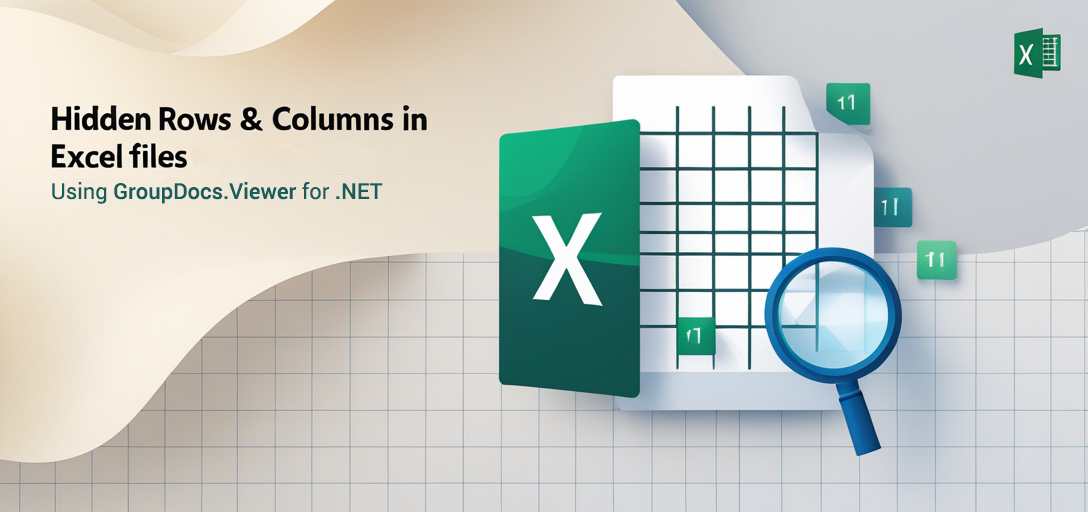Render Hidden Rows & Columns in Excel Files Using GroupDocs.Viewer for .NET
Introduction
Working with complex spreadsheets often involves handling hidden rows and columns that contain critical information. Efficiently displaying these elements without modifying the original document structure is crucial. GroupDocs.Viewer for .NET excels at rendering hidden rows and columns in Excel documents, making it an invaluable tool for financial reports or project management spreadsheets.

In this tutorial, we’ll demonstrate how to use GroupDocs.Viewer to effectively render those elusive hidden elements. By the end of this guide, you’ll know how to:
- Configure GroupDocs.Viewer for .NET to display hidden rows and columns
- Integrate rendering functionalities into your C# applications
- Optimize performance when handling large Excel files
Prerequisites
Before starting, ensure you have:
- .NET Development Environment: Set up a development environment such as Visual Studio.
- GroupDocs.Viewer Library: Install GroupDocs.Viewer for .NET (version 25.3.0).
- Sample Excel File: Prepare an Excel file with hidden rows and columns to test the implementation.
Setting Up GroupDocs.Viewer for .NET
To begin, add the GroupDocs.Viewer library to your project using either of these methods:
NuGet Package Manager Console
Install-Package GroupDocs.Viewer -Version 25.3.0
.NET CLI
dotnet add package GroupDocs.Viewer --version 25.3.0
Next, obtain a free trial or temporary license for full access to the library’s features at GroupDocs. Initialize and set up GroupDocs.Viewer in your C# application:
using System;
using GroupDocs.Viewer;
// Initialize Viewer object with a path to your Excel document
using (Viewer viewer = new Viewer("path/to/your/sample.xlsx"))
{
// Your rendering logic will go here
}
This setup prepares you for implementing advanced features like rendering hidden rows and columns.
Implementation Guide
Rendering Hidden Rows and Columns
Focus on rendering hidden elements in Excel files using GroupDocs.Viewer. Here’s how it works:
Initializing the Viewer Object
Create a Viewer object with your sample document containing hidden rows or columns.
string outputDirectory = @"YOUR_OUTPUT_DIRECTORY";
string pageFilePathFormat = Path.Combine(outputDirectory, "page_{0}.html");
using (Viewer viewer = new Viewer(@"YOUR_DOCUMENT_DIRECTORY/SAMPLE_XLSX_WITH_HIDDEN_ROW_AND_COLUMN"))
{
// Additional configurations will be done here
}
Configuring HtmlViewOptions
Set up HtmlViewOptions to render the document with embedded resources.
// Define options for HTML rendering with embedded resources
HtmlViewOptions options = HtmlViewOptions.ForEmbeddedResources(pageFilePathFormat);
Enabling Hidden Rows and Columns Rendering
Configure SpreadsheetOptions within HtmlViewOptions to enable the rendering of hidden rows and columns.
options.SpreadsheetOptions.RenderHiddenColumns = true;
options.SpreadsheetOptions.RenderHiddenRows = true;
This step ensures that all hidden data in your Excel file is visible when rendered as HTML.
Rendering the Document
Finally, use the View method to render the document with specified options:
viewer.View(options);
Troubleshooting Tips
- Document Path Issues: Ensure paths are correctly defined and accessible.
- Version Compatibility: Verify that GroupDocs.Viewer version 25.3.0 is compatible with your environment.
Practical Applications
- Financial Reporting: Display hidden financial data without altering the original spreadsheet for transparency and audit purposes.
- Project Management: Visualize all tasks, including those marked as complete or inactive, to ensure comprehensive project tracking.
- Data Analysis: Uncover insights from hidden rows/columns during extensive data analysis processes.
Integration with other .NET systems can enhance functionalities, such as connecting the rendering process to a web application for dynamic report generation.
Performance Considerations
- Optimize memory usage by managing document views efficiently and disposing of resources promptly.
- Leverage batch processing when dealing with multiple documents to reduce overhead.
Adhering to best practices in .NET memory management ensures that your applications remain performant even with large Excel files.
Conclusion
You’ve learned how to use GroupDocs.Viewer for .NET to render hidden rows and columns in Excel spreadsheets. This powerful feature enhances data visibility without altering the original document structure, making it invaluable for various professional scenarios.
Continue exploring other functionalities of GroupDocs.Viewer by visiting their documentation or try implementing this solution in your next project.
FAQ Section
- Can I render hidden elements in large Excel files?
- Yes, GroupDocs.Viewer handles large files efficiently with proper configuration.
- Do I need a permanent license to use GroupDocs.Viewer?
- A free trial is available for initial testing; purchase or temporary licenses are required for extended usage.
- Is this feature supported across all .NET platforms?
- Yes, it’s compatible with various .NET frameworks and versions.
- How do I handle errors during rendering?
- Implement exception handling to catch and resolve issues such as file path errors or unsupported document formats.
- Can GroupDocs.Viewer be integrated into existing applications easily?
- Absolutely, its API is designed for seamless integration with .NET applications.
Resources
- Documentation: GroupDocs Viewer .NET Documentation
- API Reference: API Reference Guide
- Download: Latest Releases
- Purchase: Buy GroupDocs.Viewer
- Free Trial: Try for Free
- Temporary License: Request a Temporary License
- Support Forum: GroupDocs Support Forum